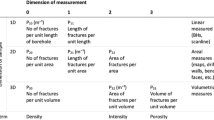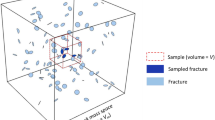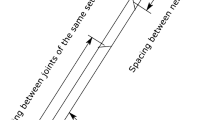Abstract
Recent mathematical calculations allow us to define set fracture intensity (I), i.e., the amount of rock mass affected by fracture sets, independently of the investigation mode. This parameter, characteristic of each rock mass, is of much interest to describe the mechanical response of the rock mass to external influences. The aim of this work is to apply these mathematical equations on one site using measurements of three distinct fracture sets: (1) on a plane surface, (2) along a scanline, and (3) using borehole imaging, in order to evaluate and explain variability in collected data. Even if the three types of measurements give differences on absolute intensity values, they still define similar trends, i.e., the order of the fracturing impact of joint sets is the same from the three measurement methods, irrespective of the fact that obtained values are quite different from one survey method to another. We discuss the possible origins of these biases.






Similar content being viewed by others
References
AFTES (2003) Recommandations relatives à la caractérisation des massifs rocheux utile à l’étude et à la réalisation d’ouvrages souterrains. Tunnels et ouvrages souterrains 177:138–186
Aydan O, Ulusay R, Tokashiki N (2013) A new rock mass quality rating system: rock mass quality rating (RMQR) and its application to the estimation of geomechanical characteristics of rock masses. Rock Mech Rock Eng. doi:10.1007/s00603-013-0462-z
Baecher GB (1983) Statistical analysis of rock mass fracturing. J Math Geol 15(2):329–347
Barton N (2002) Some new Q-value correlations to assist in site characterization and tunnel design. Int J Rock Mech Min Sci 39:185–216
Bienawski ZT (1989) Engineering rock mass classifications. Wiley, New York
Bogdonov AA (1947) The intensity of cleavage as related to the thickness of beds. Sov Geol 16:102–104
Chantron I, Zumbo V (2002) Formalisation des critères descriptifs d’un massif rocheux—Mise au point d’une feuille de saisie des discontinuités. JNGG 2002, 8 et 9 octobre 2002, Nancy
Choukroune P (1972) Relations entre tectonique et métamorphisme dans les terrains secondaires de la ZNP centrale et orientale. Bull Soc Géol. France, XIV
Corbett K, Friedman M, Spang J (1987) Fracture development and mechanical stratigraphy of Austin Chalk, Texas. AAPG Bull 71:17–28
Das Gupta U (1978) A study of fractured reservoir rocks, with special reference to Mississipian carbonate rocks of southwest Alberta. PhD thesis, University of Toronto
Gasc-Barbier M, Wassermann J (2013) Étude de l’anisotropie des roches par méthode ultrasonique—application au gneiss de Valabres (06). BLPC (in press)
Gasc-Barbier M, Fouché O, Gaillard C (2009) Comparison between cores and borehole images in fracture networks knowledge. In: Eurocks 2009. CRC Press, Dubrovnik, Cavtat, Croatia, pp 109–114
Gasc-Barbier M, Virely D, Guittard J (2013) Field investigations and laboratory testing on a marble site—case for further studies (in preparation)
Golberg JM (1987) Le métamorphisme mésozoïque dans la partie orientale des Pyrénées : relations avec l’évolution de la chaîne au Crétacé. Thèse, Université Montpellier II
Gross MR (1993) The origin and spacing of cross joints: examples from the Monterrey Formation, Santa Barbara coastline, California. J Struct Geol 15:1303–1318
Grossmann NF (1988) About the joint set intensity. In Romana M (ed) Rock mechanics and power plants/Mécanique des roches et centrales energétiques/Felsmechanik und Kraftwerksbau; proceedings of the international symposium, Madrid, 1988 September 12–16 1:41–47
Grossmann NF (2011) About the determination of the joint set intensity. In: Qian Q, Zhou Y (eds) Harmonising rock engineering and the environment. CRC, Leiden
Guittard J, Souvignet S, Gasc-Barbier M, Virely D (2005) Field investigations realized for Saint-Béat tunnel (France–31). Geoline 2005 23–25 May 2005, Lyon. CD-Rom
Gurocak Z (2011) Analyses of stability and support design for a diversion tunnel at the Kapikaya dam site, Turkey. Bull Eng Geol Environ 70:41–52
Handin J, Hager RV Jr, Friedman M, Feather JN (1963) Experimental deformation of sedimentary rocks under confining pressure; pore pressure tests. AAPG Bull 47:717–755
Hoek E (1994) Strength of rock and rock masses. New J ISRM 2(2):4–16
Huang Q, Angelier J (1989) Fracture spacing and its relation to bed thickness. Geol Mag 126:355–362
Hudson JA, Priest SD (1983) Discontinuity frequency in rock masses. Int J Rock Mech Min Sci Geomech Abstr 20:73–89
ISRM (International Society for Rock Mechanics) (1981) In: Brown ET (ed) ISRM suggested method: rock characterization, testing and monitoring. Pergamon, London
ISRM (International Society for Rock Mechanics) (2012) Panel discussion on the incorporation of structural geology information into rock mechanics modeling and rock engineering design—report on the 28 May 2012, Eurock 2012, 28–30 may 2012, Stockholm, Sweden
Ji S, Saruwatari K (1998) A revised model for the relationship between joint spacing and layer thickness. J Struct Geol 20:1495–1508
Kulatilake PHSW, Wu TH (1984) Sampling bias on orientation of discontinuities. Rock Mech Rock Eng 17:243–253
Lorenz JC, Hill RE (1991) Subsurface fracture spacing: comparison of inferences from slant/horizontal core and vertical core in Mesaverde reservoirs. In: Society of Petroleum Engineers, Rocky Mountain regional meeting and low-permeability reservoirs symposium, Denver, April 15–17, SPE Paper 21877, pp 705–716
Mandal N, Deb SK, Khan D (1994) Evidence for a non-linear relationship between fracture spacing and layer thickness. J Struct Geol 16:1275–1281
Marinos E, Marinos P, Hoek E (2005) The geological strength index: applications and limitations. Bull Eng Geol Environ 64:55–65
Mauldon M, Dunne WM, Rohrbaugh MB (2001) Circular scanlines and circular windows: new tools for characterizing the geometry of fracture traces. J Struct Geol 23:247–258
Narr W (1991) Fracture density in the deep subsurface: techniques with application to Point Arguello oil field. APPG Bull 75:1300–1323
Narr W (1996) Estimating average fracture spacing in subsurface rock. AAPG Bull 80:1565–1586
Narr W, Suppe J (1991) Joint spacing in sedimentary rocks. J Struct Geol 13:1037–1048
Nelson RA (1985) Geologic analysis of naturally fractured reservoirs. Gulf, Houston
Ortega OJ, Marrett RA, Laubach SE (2006) A scale-independent approach to fracture intensity and average spacing measurement. AAPG Bull 90:193–208
Palmstrom A (1982) The volumetric joint count—a useful and simple measure of the degree of rock mass jointing. IAEG Congress, New Delhi, pp V.221–V.228
Palmstrom A (2005) Measurements of and correlations between block size and rock quality designation (RQD). Tunn Undergr Space Technol 20:362–377
Palmstrom A, Broch E (2006) Use and misuse of rock mass classification systems with particular reference to the Q-system. Tunn Undergr Space Technol 21:575–593
Park HJ, West TR (2002) Sampling bias of discontinuity orientation caused by linear sampling technique. Eng Geol 66:99–110
Priest SD (1985) Hemispherical projection methods in rock mechanics. George Allen & Unwin, London
Priest SD (1993) Discontinuity analysis for rock engineering. Chapman and Hall, London
Priest SD, Hudson JA (1976) Discontinuity spacing in rock. Int J Rock Mech Min Sci Geomech Abstr 13:135–148
Priest SD, Hudson JA (1981) Estimation of discontinuity spacing and trace length using scanline surveys. Int J Rock Mech Min Sci 18:183–199
Rives T, Rawnsley KD, Petit JP (1994) Analogue simulation of natural orthogonal joint set formation in brittle varnish. J Struct Geol 16:419–429
Sinclair SW (1980) Analysis of macroscopic fractures on Teton anticline, Northwestern Montana. M.S. thesis. Texas A&M University, College Station, Texas
Terzaghi R (1965) Sources of error in joint surveys. Geotechnique 15:287–304
Virely D, Guittard J, Gasc-Barbier M (2006) Caractérisation expérimentale et in situ de la matrice et des discontinuités rocheuses: cas du tunnel de Saint-Béat. JNGG 2006, Lyon, France
Yow JL (1987) Blind zones in the acquisition of discontinuity orientation data. Int J Rock Mech Min Sci Geomech Abstr 23(1):19–28
Author information
Authors and Affiliations
Corresponding author
Rights and permissions
About this article
Cite this article
Mahé, S., Gasc-Barbier, M. & Soliva, R. Joint set intensity estimation: comparison between investigation modes. Bull Eng Geol Environ 74, 171–180 (2015). https://doi.org/10.1007/s10064-014-0572-1
Received:
Accepted:
Published:
Issue Date:
DOI: https://doi.org/10.1007/s10064-014-0572-1




